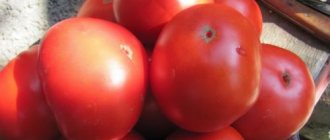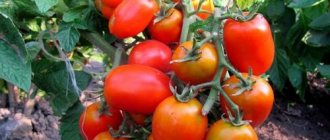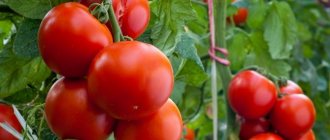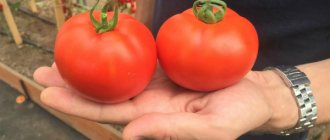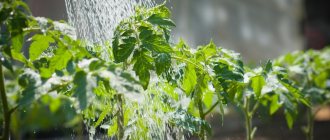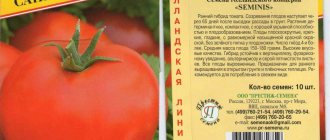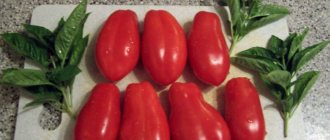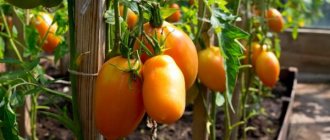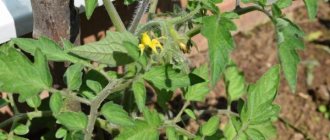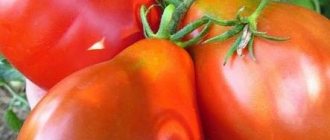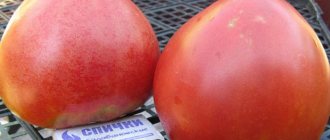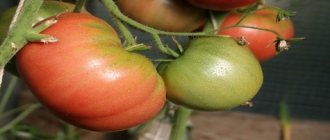| Ripening period: | early ripening (95 days from sowing) |
| Shape, weight of fruits: | spherical, weighing 100 g |
| Bush height: | 65-80 cm |
| Regions for cultivation: | in open ground to the latitude of the Moscow region, to the north - in greenhouses |
| Productivity: | up to 3.5 kg per plant |
Modern varieties and hybrids of tomatoes delight vegetable growers with stable yields and excellent disease resistance. The Leopold F1 tomato was created by Russian breeders 20 years ago and has received well-deserved recognition. Gardeners appreciate its productivity, unpretentiousness and versatility in cooking.
Characteristics of the hybrid variety
The authorship of the creation of the Leopold hybrid belongs to the Gavrish company. This company is famous for creating varieties of tomatoes and other vegetables adapted to the climatic conditions of Russia. This tomato is intended for growing in open ground or in greenhouses and film tunnels.
The Leopold tomato belongs to determinate plants, reaching a height of 80 cm. The leaves are slightly wrinkled, dark green, and medium in size. The main stem stops growing after the formation of the 6th flower raceme.
To increase yield, it is recommended to grow a hybrid with 2-3 stems. An additional harvest is obtained by leaving 1-2 strong side shoots.
The appearance of the Leopold variety plant can be assessed from the photographs presented.
The Leopold variety is recommended for growing by beginning gardeners. Minor errors in agricultural technology do not affect the final harvest.
Each cluster grown on a tomato stem grows up to 7 spherical fruits. They are uniform in size and weigh 90-105 g. The skin of tomatoes is smooth and bright red when fully ripe.
Tomatoes have a pleasant sweet and sour taste and pronounced aroma. The purpose of the fruits is universal: they are used for pickling, pickling, eaten fresh, and prepared in stews and sauces.
The Leopold hybrid yields its harvest 3 months after seed germination. 3-3.5 kg of healthy, beautiful fruits are removed from each plant. From 1 sq. m of protected soil, with compacted planting, 10 kg of tomatoes are harvested.
Tomato Leopold
photo author Lyudmila Kamenichenko
Description and characteristics of tomato Leopold F1, reviews, photo of the bush
Early ripening, determinate, medium-sized, cluster tomato hybrid for open ground, film shelters, greenhouses.
The bush is medium branched and medium leafy, up to 1 meter high. Requires tying to the support and pinning. The manufacturer recommends forming this plant into 2 stems.
The leaf of this tomato is ordinary, dark green, glossy, slightly corrugated. The inflorescence is intermediate, the first inflorescence is formed above 6-8 leaves, the subsequent ones every 1-2 leaves. The fruits are collected in clusters of 6-8 pieces.
Basic qualities of fruits
The fruits are round, smooth, matte, red in color at maturity, weighing 90-100 grams, sweet and tasty. Not prone to cracking, durable and transportable. These tomatoes are universal in purpose - perfect for both fresh salads and canning.
Advantages of the hybrid : early ripeness, friendly yield, high marketability and excellent taste of the fruit. The hybrid is resistant to the pathogens of tobacco mosaic virus, cladosporiosis and fusarium.
Tomato Leopold F1 is included in the State Register for the 3rd light zone for garden plots, household plots and small farms.
Seed producer : agricultural company Gavrish.
Features of cultivation, planting and care
Sowing seeds for seedlings is carried out 55-60 days before the intended planting in the ground. Picking - at the stage of two true leaves. When planting seedlings in a permanent place per 1 sq. m of plot, it is recommended to place up to 4 plants, and when forming into 1 stem - up to 6.
Further care for tomatoes consists of timely watering, pinching, weed removal, fertilizing with complex mineral fertilizers and preventive measures to protect the crop from diseases and pests.
If you grew Leopold tomatoes, please write whether you liked them or not. What was the yield and taste of the fruits like under your climatic conditions? How do you rate the disease resistance of this tomato? If possible, attach a photo of the entire bush or individual fruits you grew to your comment. Thank you!
Your reviews of the Leopold tomato and additions to the description will help our readers evaluate this hybrid objectively and decide whether it is worth planting or not.
Planting and care
For seedlings, Leopold seeds are sown 60-65 days before planting the plants in the garden. The seedlings are kept in a bright room, at a temperature of +20 +22 degrees.
The time of removal of tomatoes to a permanent place of growth is determined by the climate of the growing region:
- in the middle zone and Moscow region, tomatoes are planted in open ground in late May - early June;
- in the Leningrad region and the Southern Urals - in mid-June;
- in the middle and northern Urals, in Siberia, tomatoes are grown in greenhouses, planting seedlings in shelters no earlier than June;
- in the south, plants are brought out into the fresh air at the beginning of May.
Tomato seedlings are planted when the soil temperature has reached +15 degrees and the air has warmed up to +18 +20 degrees. A decrease in temperature to 0 leads to the death of plants.
Leopold is planted in loose and fertile soil. A distance of 40 cm is maintained between the bushes. It is recommended to mulch the soil under the plants with straw dust or shavings in a layer of 8 cm. This coating retains moisture deep, retains heat and suppresses the growth of weeds.
Despite their short stature, Leopold tomatoes need tying to a support and pinching. Unnecessary shoots are removed regularly, preventing them from growing to large sizes.
If the bush is formed from 2-3 stems, they are tied to the supports with a fan. This way the branches will be well ventilated and evenly illuminated by the sun.
Caring for plantings consists of regular watering and fertilizing, loosening the soil (if there is no mulch). Water the tomatoes 1-2 times a week, not with cold water, strictly at the root.
Leopold tomatoes are fed 2-3 times during the summer. The plant especially needs nutrients during the period of flowering and fruiting. They use mineral and organic fertilizers, herbal infusions, and compost.
Growing stages
They consist of:
- preparation of seed material;
- sowing seeds for seedlings;
- its cultivation;
- planting seedlings in the ground;
- planting care;
- harvesting.
Is it possible to eat bread while losing weight at night?
Which breads are best for weight loss ? Here are the approximate dates of the main events for the greenhouse growing method:
- laying seeds for germination - March 20;
- sowing of germinated seeds – March 25;
- expected shoots - April 1;
- planting seedlings in greenhouse soil - May 5;
- first ripe fruits - early July.
In the calculations, the time of planting seedlings in the ground was taken as the starting point for all dates.
For unprotected soil, this is the end of May - beginning of June, when the threat of night frosts passes.
It can be planted in open ground 10 days earlier (approximately May 20), if temporary shelters made of frames and film or spunbond are provided for planting.
You can more accurately plan the rooting date of seedlings based on the long-term weather forecast.
Germination of seeds
Typically, hybrid seeds from manufacturers have already undergone all the necessary pre-sowing treatment. The germination operation has two purposes:
- This is a germination test.
- A way to speed up all growth processes.
A fabric made from natural fibers, folded in several layers and soaked in water, is placed in a small airtight container. The seeds are laid out on it, the whole thing is sealed with a lid and placed in a warm place (26-28 degrees). Seeds must not be allowed to be in water! This can encourage mold growth.
The germination process ends when the length of the white sprouts compares with the size of the seeds. This will take several days.
Sowing
It starts with preparing the soil. Any commercial soil is suitable for tomato seedlings. Your garden soil, prepared in the fall, must be disinfected by sprinkling it with a weak solution of potassium permanganate. After this, the soil is dried and filled with a full complex of NPK mineral fertilizers (nitrogen, phosphorus, potassium) in the proportion of 1 tablespoon of fertilizer per bucket of substrate. Sowing seeds should be done immediately in separate cups or cassettes. This will avoid picking, which is painful for young plants. The depth of seed placement should not exceed 1 cm.
Seedling care
Excessive watering can lead to root rot. Therefore, it must be carried out when the top layer of soil dries. To prevent the seedlings from bending, you need to regularly change its position relative to the light source.
The quality of seedlings can be significantly improved if transshipment is done, i.e. transplant the young plant into a large container with the stem buried.
In this case, the tomato, like all nightshades, will begin to grow new roots from the buried stem. A more powerful root system stimulates proportional crown growth.
This operation is repeated a second time when rooting the seedlings into the ground. Moreover, if the size of the seedlings is too large, they can be planted obliquely (lying down).
Landing in the ground
Leopold's compact plants allow a thickening of 5 bushes per square meter. meter, which leads to a pattern of 50x40 cm. A teaspoon of full composition of fat and a pinch of ash is first added to the planting hole, this composition is mixed with the ground. Here, before planting, a support peg is driven in.
Disease resistance
Leopold F1 is characterized by increased immunity to diseases common among tomatoes:
- tobacco mosaic virus;
- fusarium;
- cladosporiosis.
Under unfavorable climatic conditions (cold, high humidity) and poor agricultural practices (excess nitrogen fertilizers, dense planting), Leopold tomatoes may suffer from fungal infections. To prevent this from happening, in unfavorable damp summers it is recommended to spray the plants with antifungal drugs (Fitosporin, Planriz, Trichodermin). These products are biological fungicides and do not accumulate in fruits.
How to grow
The greatest results from cultivation can be achieved using the greenhouse method. But, of course, the Zlatava tomato can be planted in a garden in an open area. With the first option, you need to constantly monitor the temperature and humidity.
Important! During planting work, you need to carefully disinfect equipment: planting boxes, plastic containers, soil, bowls, glasses, etc. You must wear rubber gloves on your hands. There are often cases when “infection” enters the garden from seeds and containers
Therefore, seeds also need to be disinfected, and used containers should be treated
There are often cases when the “infection” enters the garden from seeds and containers. Therefore, seeds also need to be disinfected, and used containers should be treated.
When to sow
Zlatava should be planted from March to April, presumably 1.5 months before transplanting into a greenhouse or soil. The closer to warmer times you sow, the higher the sun's activity will be, and the faster the plants will grow.
Important! If you plant seedlings in early April, they will be practically no different from plants planted in mid-March.
The soil
It should consist of 40% peat, 25% specially purchased high-quality soil, fertilized with useful minerals and trace elements, as well as 30% steamed garden soil.
Sowing technology
In the container for seedlings (there should be drainage in the lower part to remove excess moisture), you need to pour 6 cm of fine charcoal, pre-mixed with planting soil. Mix the fractions thoroughly and compact.
Then, at a distance of about 3 cm from each other, you need to make grooves in the soil. Their depth should be no more than 1 cm. Now you can moisten the soil with a weak solution of potassium humate. The most convenient way to do this is with a spray bottle.
Now you can put tomato seeds in the “trenches”. The distance should be about 2.5 cm. With a weak humate solution, you need to re-moisten the seedlings slightly pressed into the soil.
You need to cover the seeds with dry soil in a 1 cm layer, which then needs to be crushed. Next, the containers are sent for maturation to a dry place, with an air temperature of about 30 degrees. This variety requires heat.
Care and transplantation
After the plants sprout their first shoots (appear approximately 10 days after planting), you need to remove the container with the seedlings and place the tomatoes under a source of constant light for 4 days.
For the first 2-3 days, the air temperature should be about 16 degrees during the daytime, and at least 11 at night. This is necessary to protect the tomatoes from being pulled out and to form a more or less powerful root system.
Tomatoes should receive light no more than 15 hours a day. If it is not possible to create such conditions, then the seedlings can simply be illuminated with an ordinary lamp. After a week, the temperature should be +25 degrees during the day, and at least +13 at night. Now you can pick the plants.
To do this you need:
- Prepare a 350 ml container, make holes in it for drainage, and pour 2 cm of medium-sized wood charcoal into it. The latter can be taken from a barbecue, or you can buy a similar one in a store;
- Fertilizer that does not contain nitrogen is placed at the bottom of the container. For example, Borofoska. Volume – 1 teaspoon. Next, you need to fill the container halfway with soil;
- The seedling, using a small spoon, must be removed from its previous “place of residence” and transferred to a new container;
- The root system must be carefully covered with soil so that air “cushions” do not form in the container;
- Now the seedlings are watered with 1 tsp. weak solution of nitrate, per 1 liter. water. From above, the plants are filled to the top with the remaining soil.
Next, the containers with seedlings must be placed in a dry place and provided with lighting. Do not water. Subsequent watering can be done after at least 5 days so that the lumps of earth are completely wet.
All further watering should be done after the soil has completely dried. If the tomatoes begin to wilt a little, then they need to be strengthened with a solution of potassium humate in a volume 30% less than recommended in the instructions.
The remaining fertilizing should be carried out no more than 3 times during the entire period of plant growth. The best option is calcium nitrate in a volume of 1 tsp. per liter of water.
After the first leaves appear, you need to provide the seedlings with the following temperature regime - about 20 degrees during the day, and about 11 at night. Tomatoes must be illuminated for at least 15 hours a day.
Before the seedlings are planted in the ground, they need to be prepared. To do this, the temperature conditions must be made more “strict” for 2-3 hours a day. During the day, reduce to 15, at night - to 8. After 55 days, the tomatoes can be replanted.
Advantages and disadvantages
Gardeners already familiar with the Leopold hybrid note the following advantages of the plant:
- compact tomato size;
- resistant to diseases and temperature changes;
- early maturation;
- high yield rates;
- the size and density of the fruit are well suited for pickling.
The disadvantages include the need for gartering and pinching of the bush, and some sourness in the taste. No other significant disadvantages were identified in the variety.
Disease resistance
Starling exhibits high resistance to many crop diseases. It does not suffer from crown and root rot, from tomato mosaic virus, brown and bacterial spot, as well as bacterial wilt.
Due to the early ripening of his tomatoes, in most regions he manages to harvest before late blight spreads. However, in conditions of rainy, cool summers, the bushes need preventive treatment with fungicides against this disease.
Among the pests, slugs can damage the hybrid. Therefore, when signs of damage appear, it is necessary to sprinkle tobacco dust or wood ash at the base of the bushes, which will help scare them away.
Similar hybrids
According to the characteristics and description of the Leopold variety, it is similar to the following hybrids:
- Verlioka. A hybrid plant that produces a crop 115 days after sowing. The length of the tomato stem in open ground is 120 cm, in a greenhouse it reaches 150 cm. The fruits are small, spherical, red, weighing 100 g. The pulp is sweet and sour, dense, juicy. The skin does not crack when the tomato ripens. Productivity up to 5 kg from 1 bush.
- Buddy. An early low-growing tomato variety for open ground and film tunnels. Stem height is 55-60 cm, requires shaping and garter. The fruits are flat-round in shape with slight ribbing, weighing 100 g. The color is red, the taste is sweetish. The use of tomato is universal. From 1 sq. m harvest up to 9 kg of crop, subject to compliance with all agrotechnical cultivation rules.
- Blagovest tomatoes. Hybrid from the company Gavrish. Recommended for growing in a greenhouse. The height of the bush is 160-170 cm, which needs staking and pinching. The plant has high innate immunity to TMV, fusarium, and cladosporiosis. The fruits are round, red, weighing 110 g. Their pulp is dense and sweet. Tomatoes are suitable for fresh consumption and pickling. From sq. m. they get 10-12 kg of harvest in protected soil conditions.
Other varieties similar to the Leopold tomato also have good reviews: White filling, Gina, Debut, and Riddle tomatoes.
Characteristics
Powerful Leopold tomato bushes are determinate, 70-80 cm, stop growing after the formation of 5-6 flower clusters on the plant. In greenhouses, growing on nutritious soil, tomato bushes can rise up to 1 m. The plants of these tomatoes do not need to be pinched. But when the stepsons are removed, the yield will be greater.
Plants of this hybrid do not require special care. The bushes have phenomenal resistance to major tomato diseases. And if we add resistance to dropping above-zero temperatures to this characteristic property, it is quite clear why the Leopold hybrid is truly a godsend for beginning gardeners. Even without adhering to all the rules of agricultural technology, but simply by watering and weeding the beds, you can get a sufficient harvest.
The hybrid of early ripening tomatoes has been tested by gardeners. Leopold tomato bushes grow well in greenhouses, under film or non-woven cover in the middle climate zone and in open gardens. The plant will produce a stable harvest of fruits - up to 3-4 kg per bush, which are suitable for fresh consumption and for various preparations. These tomatoes are valued for their early and vigorous ripening, high marketability of attractive fruits, and their wonderful taste.
Ginseng beneficial properties and contraindications || Ginseng root - properties and use in folk medicine
Description of fruits
This variety belongs to the ultra-early variety. This suggests that the harvest can be harvested in the first month of summer. At the same time, the plant is distinguished by its friendly yield of fruits, which is convenient for housewives who use tomatoes for winter harvesting.
In general, the Leopold tomato variety is considered universal. Its fruits are suitable for preparing summer vegetable salads, but they are best used for canning, as evidenced by numerous reviews. Consumers especially like whole-fruit pickling and salting.
This is because tomatoes are very convenient. They are round and almost identical in size. The average weight of 1 tomato is 100 g. The fruits are red, but there is a green dot at the stalk. This variety is suitable for whole-fruit canning due to the fact that tomatoes have a very thick skin. Thanks to this, the fruits never crack in the jars and last all winter.
Thanks to their dense pulp and skin, Leopold tomatoes can be stored for a long time. This allows this hybrid to be used for industrial cultivation. Tomatoes can not lose their taste and external qualities for a long time. Even after several weeks of storage, the tomatoes remain in excellent presentation.
Since the Leopold hybrid is characterized by a very high yield, characteristic of this determinate variety, there will be enough tomatoes for both canning and fresh consumption. The taste of the fruits is sweetish, but with pronounced sourness.
This variety can be cut fresh into salads or eaten raw. Since the size of the fruit is not large, it is very convenient to cover the tomatoes for the winter.
